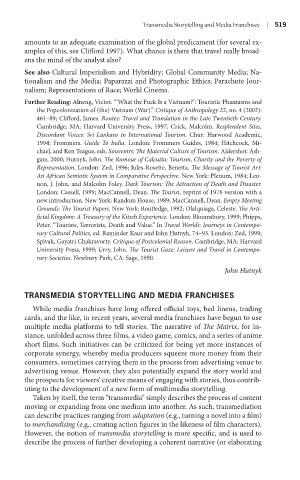Page 540 - Battleground The Media Volume 1 and 2
P. 540
Transmed a Storytell ng and Med a Franch ses | 1
amounts to an adequate examination of the global predicament (for several ex-
amples of this, see Clifford 1997). What chance is there that travel really broad-
ens the mind of the analyst also?
see also Cultural Imperialism and Hybridity; Global Community Media; Na-
tionalism and the Media; Paparazzi and Photographic Ethics; Parachute Jour-
nalism; Representations of Race; World Cinema.
Further reading: Alneng, Victor. “ ‘What the Fuck Is a Vietnam?’: Touristic Phantasms and
the Popcolonization of (the) Vietnam (War).” Critique of Anthropology 22, no. 4 (2002):
461–89; Clifford, James. Routes: Travel and Translation in the Late Twentieth Century.
Cambridge, MA: Harvard University Press, 1997; Crick, Malcolm. Resplendent Sites,
Discordant Voices: Sri Lankans in International Tourism. Chur: Harwood Academic,
1994; Frommers. Guide To India. London: Frommers Guides, 1984; Hitchcock, Mi-
chael, and Ken Teague, eds. Souvenirs: The Material Culture of Tourism. Aldershot: Ash-
gate, 2000; Hutnyk, John. The Rumour of Calcutta: Tourism, Charity and the Poverty of
Representation. London: Zed, 1996; Jules-Rosette, Benetta. The Message of Tourist Art:
An African Semiotic System in Comparative Perspective. New York: Plenum, 1984; Len-
non, J. John, and Malcolm Foley. Dark Tourism: The Attraction of Death and Disaster.
London: Cassell, 1999; MacCannell, Dean. The Tourist, reprint of 1976 version with a
new introduction. New York: Random House, 1989; MacCannell, Dean. Empty Meeting
Grounds: The Tourist Papers. New York: Routledge, 1992; Olalquiaga, Celeste. The Arti-
ficial Kingdom: A Treasury of the Kitsch Experience. London: Bloomsbury, 1999; Phipps,
Peter. “Tourists, Terrorists, Death and Value.” In Travel Worlds: Journeys in Contempo-
rary Cultural Politics, ed. Raminder Kaur and John Hutnyk, 74–93. London: Zed, 1999;
Spivak, Gayatri Chakravorty. Critique of Postcolonial Reason. Cambridge, MA: Harvard
University Press, 1999; Urry, John. The Tourist Gaze: Leisure and Travel in Contempo-
rary Societies. Newbury Park, CA: Sage, 1990.
John Hutnyk
transMedia storytelling and Media FranChises
While media franchises have long offered official toys, bed linens, trading
cards, and the like, in recent years, several media franchises have begun to use
multiple media platforms to tell stories. The narrative of The Matrix, for in-
stance, unfolded across three films, a video game, comics, and a series of anime
short films. Such initiatives can be criticized for being yet more instances of
corporate synergy, whereby media producers squeeze more money from their
consumers, sometimes carrying them in the process from advertising venue to
advertising venue. However, they also potentially expand the story world and
the prospects for viewers’ creative means of engaging with stories, thus contrib-
uting to the development of a new form of multimedia storytelling.
Taken by itself, the term “transmedia” simply describes the process of content
moving or expanding from one medium into another. As such, transmediation
can describe practices ranging from adaptation (e.g., turning a novel into a film)
to merchandising (e.g., creating action figures in the likeness of film characters).
However, the notion of transmedia storytelling is more specific, and is used to
describe the process of further developing a coherent narrative (or elaborating

